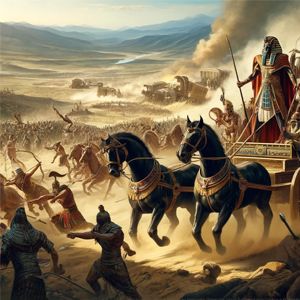 The Battle of Megiddo, fought on April 16, 1457 BCE, stands as one of the most significant and well-documented events of the ancient Near East. This confrontation marked a pivotal moment in the military campaign of Thutmose III, the sixth Pharaoh of Egypt’s Eighteenth Dynasty, against a coalition of Canaanite kingdoms. It was not just a military engagement but a clash that would shape the geopolitical landscape of the region for centuries and leave a lasting legacy in the annals of military history.
The Battle of Megiddo, fought on April 16, 1457 BCE, stands as one of the most significant and well-documented events of the ancient Near East. This confrontation marked a pivotal moment in the military campaign of Thutmose III, the sixth Pharaoh of Egypt’s Eighteenth Dynasty, against a coalition of Canaanite kingdoms. It was not just a military engagement but a clash that would shape the geopolitical landscape of the region for centuries and leave a lasting legacy in the annals of military history.
The primary sources of our knowledge about the Battle of Megiddo come from the annals of Thutmose III himself, recorded on the walls of the Temple of Amun at Karnak. These inscriptions provide a detailed account of his military campaigns, particularly the 17-year campaign against the Canaanite kingdoms. Thutmose III’s reign is often described as the height of Egypt’s military, cultural, and economic power, and the annals serve as a testament to his military genius and the state’s administrative capabilities.
The campaign against the Canaanite kingdoms was instigated by a revolt led by the king of Kadesh, who united a coalition of Canaanite states to rebel against Egyptian dominance. Thutmose III’s response was swift and decisive. He led his army through the coastal plain and then through a narrow pass in the Carmel Range, opting for a direct attack on Megiddo, which was the rebellion’s stronghold. This route, while dangerous, allowed Thutmose III to achieve the element of surprise and position his forces advantageously.
The battle itself unfolded at the foot of the Megiddo fortress. According to the annals, Thutmose III’s forces quickly overcame the coalition’s chariots and infantry, driving them back into the city. What followed was a seven-month siege, which ended with Megiddo’s surrender. The Egyptians utilized a combination of military tactics and engineering prowess to secure their victory, showcasing the sophistication of their siege warfare techniques.
The victory at Megiddo was a turning point for Egyptian expansion into Canaan. It led to the conquest of numerous cities and the imposition of Egyptian hegemony over the region. The spoils of war, as recorded in the annals, included vast quantities of gold, livestock, and slaves. Moreover, the victory solidified Thutmose III’s reputation as a warrior king and demonstrated the effectiveness of the Egyptian military machine.
In the aftermath, Thutmose III extended his empire to its greatest territorial extent, incorporating large parts of the Near East into the Egyptian Empire. The Canaanite kingdoms became vassal states, obligated to pay tribute and provide military support to Egypt. This period of Egyptian domination facilitated cultural exchange and economic prosperity but also sowed the seeds of future conflicts.
Beyond the textual records found in Thutmose III’s annals, archaeological excavations at Megiddo have provided additional insights into the battle’s context and aftermath. The archaeological layers corresponding to the period reveal evidence of a fortified city that underwent significant reconstruction work, likely as a result of the siege. Artefacts such as weapons, chariot parts, and pottery have helped scholars piece together the events and aftermath of the battle.
The Battle of Megiddo is not just a historical event; it has transcended its historical confines to become a symbol of strategic brilliance, military might, and the complexities of ancient warfare. It is one of the earliest recorded battles in history, providing invaluable insights into the military tactics, geopolitics, and economic conditions of the ancient Near East. The legacy of Megiddo echoes in the term “Armageddon,” a derivative of Har Megiddo (the Mount of Megiddo), highlighting the battle’s enduring impact on culture and religious thought.
The Battle of Megiddo under Thutmose III’s command was more than just a military conquest; it was a demonstration of Egypt’s power, the strategic acumen of its leaders, and the complexities of ancient Near Eastern politics. The records and archaeological evidence of the battle provide a vivid picture of the ancient world, its conflicts, and its advancements, cementing the Battle of Megiddo’s place in the annals of history.
Leave a comment